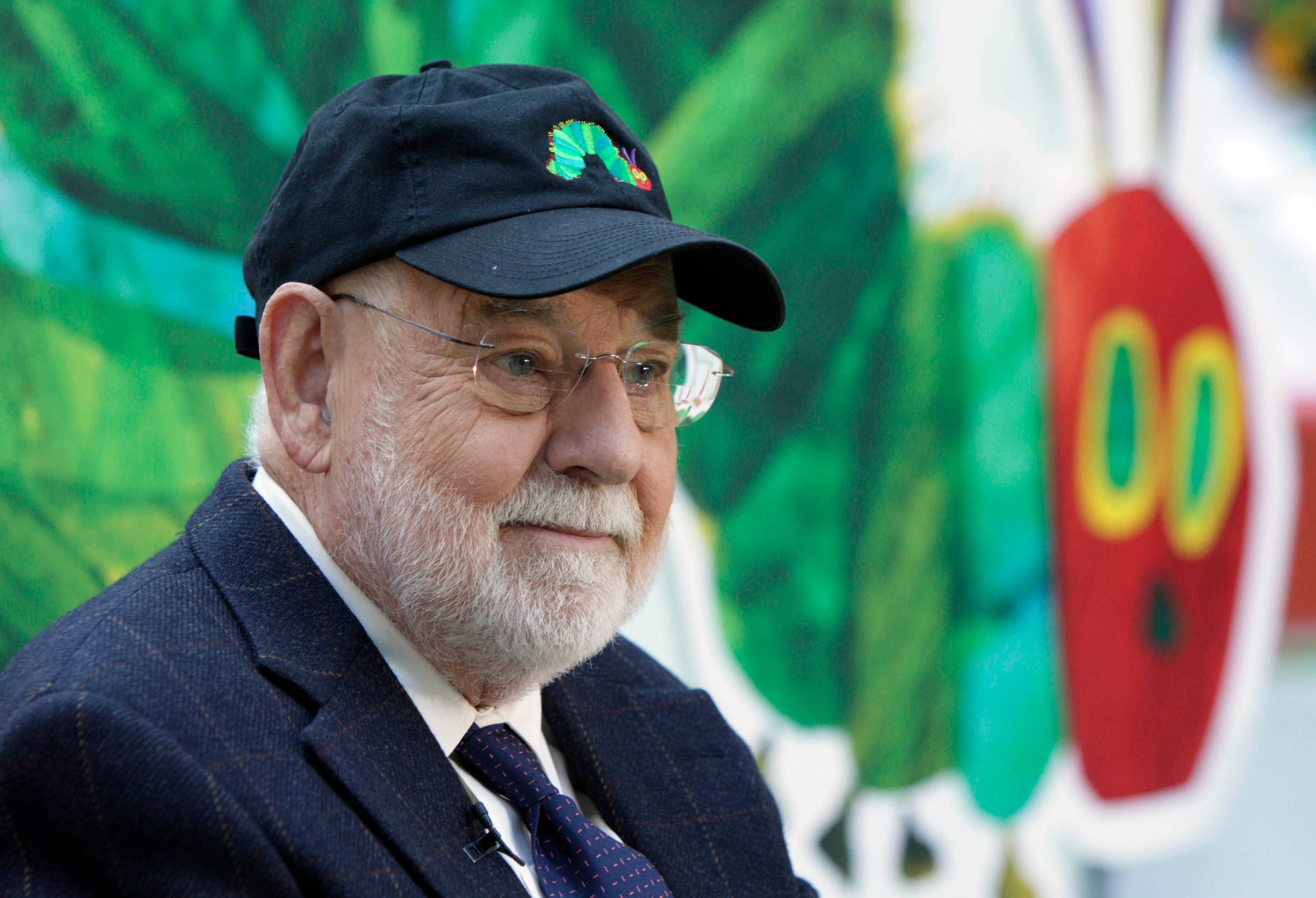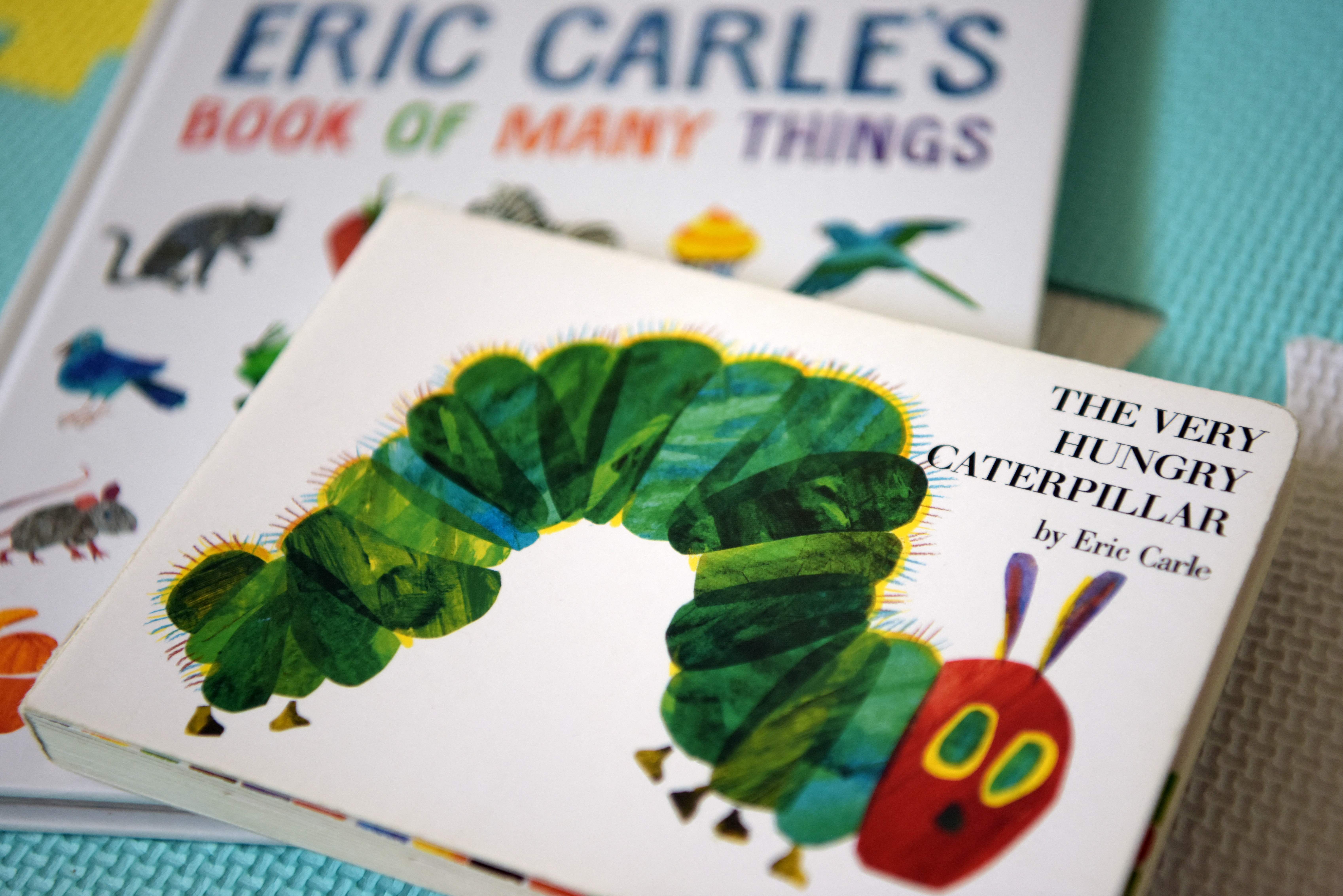Eric Carle: The very busy illustrator
Eric Carle’s book The Very Hungry Caterpillar has sold more than 20 million copies worldwide. In 2005 he told Sally Williams about growing up hungry under Hitler.

This interview was first published in 2005.
In the 35 years since the children's writer and illustrator Eric Carle published The Very Hungry Caterpillar, a copy has been bought somewhere every 57 seconds. At the last count, Carle has filled the world with 20 million hungry caterpillars. His larva has become an industry, passing into animation, jigsaws, toys, lunch boxes, T-shirts and - in Holland, at least - bottles of green shower gel.
Does the author gaze in disbelief at what his caterpillar has become? "So much from so little," says Carle, whose 70 or so stories with worldwide sales of 65 million have led to unprecedented rock-star status in the US, where he lives. "He's the Bruce Springsteen of kindergarten to third grade," says Nick Clark, director of The Eric Carle Museum of Picture Book Art in Amhurst, Massachusetts, underlining the exhilarated mobbing that greets Carle at signings and talks. He gets hundreds of letters from children every week ("Do you have a job?": Rebecca, six) and has an unexpected fan in President Bush, who nominated The Very Hungry Caterpillar as his favourite story when he was a child - even though George W was 24 when the book first came out.
"What can I do?" shrugs Carle the committed Democrat, at his home in Florida. Moreover, although he is now 75, Carle seems to be becoming more, not less prolific. He has published seven books since 2000 including Does a Kangaroo Have a Mother Too, Slowly Slowly Said the Sloth and Mister Seahorse, which was a booming hit in the US.
Now, 10 Little Rubber Ducks (Collins, £12.99) is the latest addition to his menagerie of animal tales. If you sit down and look at all Carle's books, they melt into one zoo of beasts and bugs wriggling or winging their way towards self-discovery: a mixed-up chameleon, a lonely firefly, a bad tempered ladybird. Does he stare at them and see a kindred spirit? "We're all animals," he replies. "I'm the hermit crab [from Home for Hermit Crab]; I like to be inside a lot. Maybe, it is to do with getting older, but travelling is so awful. Everyone is going to talk to you, everyone is going to invite you places and I can't handle that."
Carle and his wife Barbara (Bobbie), a former Montessori teacher, have recently bought their house in Florida to escape the deep snow of Massachusetts winters. Standing in the gleaming light-filled house on the ocean's edge near Key Largo, Carle looks every inch the picture-book success. He is small and quietly spoken with eyes that shimmer with playfulness. He may be over three score and 15, but still sees the fun in designing a tiny fly for each urinal at the Eric Carle museum to assist precision targeting.
From here, the world outside looks bright, full of colourful promise, just like in Carle's books. 10 Little Rubber Ducks may have dark moments but it carries the hallmark of Carle's happy high-noon aesthetic. Bright, colourful collages fill the pages as the ducks come through the trauma of drifting on the high seas. A former graphic designer, he squeezes as much as possible out of each page.
10 Little Rubber Ducks covers animals, opposites, numbers and directions, but all camouflaged and lightly done. "Each page works like a poster," points out Motoko Inoue, Carle's business manager. "They convey complex ideas in a simple way." Carle writes in rhythmic text - "the heartbeat of the book" - and seduces children by giving them "something extra". This is a quacking electronic sound effect, a component which, it turns out, has malfunctioned in 150,000 copies, delaying publication in the US until June. It was holes in The Very Hungry Caterpillar, flashing lights in The Lonely Firefly, pop-ups in Papa, Please Get the Moon for Me. "I want my books to be somewhere between the warmth of holding on to a toy, and the more abstract experience of book learning," he explains.
Carle has said many times that he isn't trying to preach to children, just hold their hand. There will be those who don't get Carle, who will be put off by his samey style and find Mister Seahorse a PC bore. But for children faced with the enormous task of growing up, Carle feels like the authentic voice of sympathy. "All my books are aimed at four- to six-year-olds. That period when you leave home and go to school," he explains. "Sometimes I feel I can nail it down to one day, that day when you leave the warmth and protection of home and go into the unknown. I just want to make that day a little bit easier."
In a less obvious way, Carle's books are also about his life. Born in Syracuse, NY, in 1929, to German immigrant parents, Carle was a creative child, interested in nature. His first memories of school were of a happy "sun-filled room, large sheets of paper, colourful paints and fat brushes". It was a world of colour, freedom, light. All was to change when in 1934 Carle's parents decided to move back to Germany. "Most people with any choice in the matter were going the other way," he remarks wryly. So, from the age of six, Carle grew up in Nazi Germany. He looked up to Hitler and prized Rommel's autograph. School was the first shock: classes were cramped, pencils hard, paper rationed and corporal punishment inflicted. "I didn't know this was going to happen," remembers Carle. "The other kids did: three in this hand; three in that. And they [the welts] burned. And he [the teacher] did it with all his might. I know that was a turning-point in my life."
As Germany disintegrated, Carle was evacuated, and ended up begging for food from POWs. His father, a gentle guru, who taught Eric about nature and drawing, was taken prisoner in a camp in the Soviet Union. Carle did not see him for eight years. He returned when Carle was 18. "I rushed up to him on the station platform and thought, who is this man; this bundle of misery? All he had was his musket, heavy coat and shoes tied with string. He weighed 85 pounds and was a broken man." He spent the next years in and out of sanatoriums and died a premature death. "To this day" confesses Carle, "I can barely enjoy a good meal because of thinking about my father. I am left with a sadness. It might be psychobabble, but I rehash that period of my life through my books. The child I am helping," he says, "might just be me."
If one teacher turned him off school, two others were perpetual inspirations. Herr Krauss, Carle's grammar-school art teacher, liked Carle's loose, free drawings and risked his life showing him reproductions of forbidden work by what the Nazis called "degenerate" artists: Picasso, Klee, Matisse and some German Expressionists. Then there was Professor Ernest Schneidler, who taught at the art academy in Stuttgart, where Carle trained after leaving school. After working for two years as a poster designer, Carle, aged 23, returned to America.
The move to picture books was not planned; it fulfilled no boyhood dream. "I had an average interest in picture books. I had two kids, I'd buy them books once in a while." A turning-point came, aged 38, when author Bill Martin Jr spotted an ad of Carle's, who was by now working as a freelance graphic designer and illustrator. He asked Carle to illustrate Brown Bear, Brown Bear, What Do You See? "It absolutely set me on fire," remembers Carle. "The colourful paints and fat brushes of my first school came back to me. The child inside me was beginning to come joyfully back to life."

Carle is still at his happiest in his studio, recently exploring life beyond the picture book by painting silk and aluminium, and creating abstract sculptures. With Mozart playing in the background, he spots, stipples, splashes and splatters. This is Carle's alpha state. "The whole world is gone. It is just you and these colours, so nice and simple."
Picasso's aspiration was to paint like a child; Carle, who paints for children, aspires to be like Picasso, or De Kooning. Beneath the picture-book illustrator is a frustrated fine artist. "I have been thinking, Eric, you should have been a painter from the very beginning, you should have stayed with an easel."
His plans now are to have no plans. "I have ideas all the time," he says, "but at this very moment I feel I will never do another book." He pauses. "However, if you speak to my editor, she'll say, 'Eric, I've heard it all before.' "
Biography: Eric Carle
Eric Carle was born in Syracuse, New York, in 1929, the son of a German immigrant father who became a clerk at the City Health Department. After his family re-emigrated to Germany, Carle studied graphic design in Stuttgart before returning to the US in 1952. His first children's picture book was Brown Bear, Brown Bear, What Do You See? (by Bill Martin Jnr; 1967), followed by his first solo book, 1,2,3 to the Zoo (1968) and The Very Hungry Caterpillar (1969). He has created over 70 picture books, translated into more than 30 languages; others include The Bad Tempered Ladybird (1976), The Very Busy Spider (1985); and Polar Bear, Polar Bear, What Do You Hear? (by Bill Martin Jnr; 1991). In 2003 he won the Laura Ingalls Wilder Award and Lifetime Achievement Award. Eric Carle died on Thursday 27 May 2021, aged 91.
Join our commenting forum
Join thought-provoking conversations, follow other Independent readers and see their replies
Comments


Bookmark popover
Removed from bookmarks